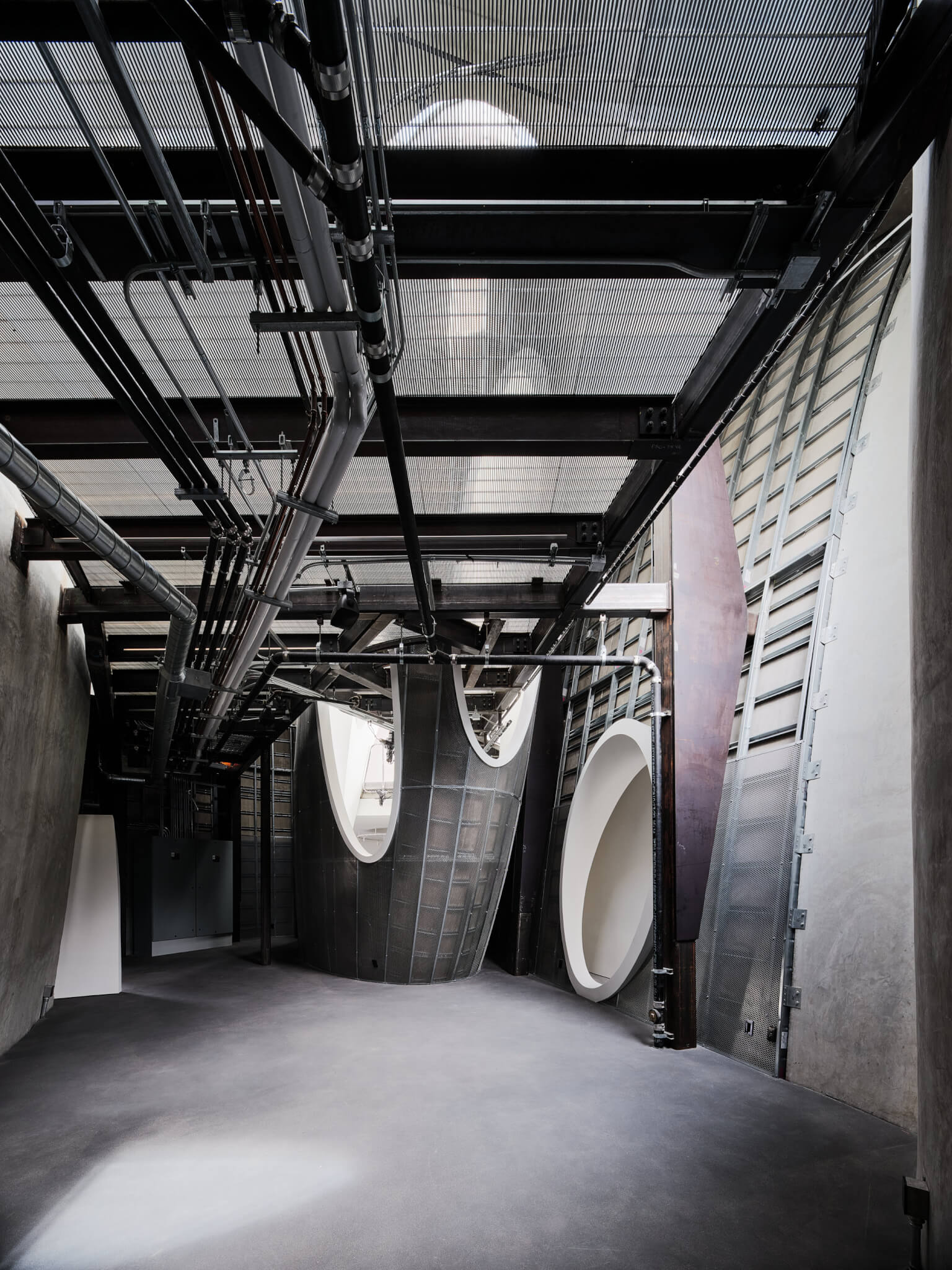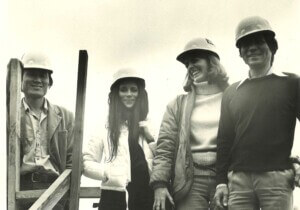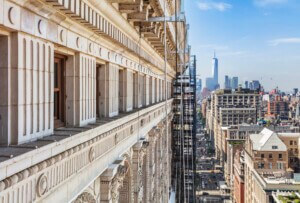In the 1990s, after working on special effects for films, Lynda Weinman taught digital media and motion graphics at Art Center College of Design in Pasadena, California, and wrote a book about designing for the World Wide Web. She founded Lynda.com in 1995 with her husband, Bruce Heavin, an illustrator and artist. Over time, the website became a popular place to learn digital skills through educational videos. The platform was acquired by LinkedIn in 2015, and that set the stage for the couple to embark on their next creative endeavor.
The architect Robin Donaldson first met Weinman and Heavin when his office, then ShubinDonaldson and now Donaldson + Partners, designed studios for Lynda.com more than a decade ago. He then worked with the couple on a renovation and the design of a home for another site before landing the commission in 2016 for this project, to be built on a hilltop site overlooking the Pacific Ocean. Most of Donaldson’s prior work was “modern and boxy,” Heavin said, which presented a challenge: “I didn’t exactly want a box.”

Donaldson had a good sense of what the residence needed programmatically, but the design process was remarkably open-ended. “I’ve worked with a lot of people in design and architecture, and many people have big egos; they’re not willing to work with you,” Heavin offered. But when he would mention half-baked ideas to Donaldson, the response was, “Yeah, let’s go.” That willingness to try something new was refreshing. “I like artists who are curious and take chances to grow,” he said.
Donaldson’s early schemes explored how the home could be integrated into the site’s landscape. At one point, a breakthrough emerged via one of Heavin’s questions: What if the whole house was the hill? The question changed the course of the project and gave it its name. “I had been flirting with that idea but hadn’t dared to show them,” Donaldson remembered.
Heavin wanted to investigate emotional and irrational themes through light, volume, forms, and space. In response, Donaldson’s team worked in Rhino and made test prints of varying scales in powder. It produced PDFs of views that Heavin would sketch over, in addition to exploring detailed digital models via VR. A new design language emerged in which voided, circular forms intersected in intricate, rhythmic ways—part sand-dollar section, part Turrell skyspace. The form was “co-ideated,” with Donaldson’s team resolving and documenting the architecture.

Donaldson was prepared for this aesthetic growth. Independently and with his D+ Workshop, an experimental fabrication outfit, he was already exploring conics, rocks, and natural forms that arise through Boolean operations and erosion—and how to fabricate them using the latest contemporary technology. The home’s design language of hollow, buried forms emerges from a lineage of Santa Barbara precedents that begins with the Mud House, a 1974 home by Roland Coate, Jr. in nearby Montecito, where the lawn was pulled over a set of cast-concrete pavilions. (It was owned for a time by the actor Steve Martin.) Thom Mayne worked for Coate and later was commissioned to design the Crawford Residence, also in Montecito, which was completed in 1990. While working at Morphosis, Donaldson was its project architect.
Both that project and the Hill House attack the primacy of the architectural object and toy in plan with a deconstructed circle, though with very different formal results. For Mayne, the impulse came from the Land Art movement, where artists were “buying tractors and completely inventing a new art form” that was based on subtraction instead of addition. Donaldson’s Hill House, through its oblong apertures, advances an expression of landscape-ness as a primary objective while simultaneously exposing its inner workings.


Hill House measures about 14,000 square feet in conditioned area and, according to Donaldson, was delivered at a typical price point for high-end homes, which can run into the thousands of dollars per square foot. One of the home’s biggest achievements is its concrete, a material Donaldson always imagined using for the residence due to its plasticity and resilience against wildfires and earthquakes. Donaldson said they used as much fly ash as possible in the concrete mix and took care to reduce the volume of concrete needed for its pours.
The formwork for the home was rationalized for construction by Gehry Technologies, and its pieces—about 3,000, nearly all of them unique—were built by CW Keller. Matt Construction, which typically builds large commercial projects, served as the general contractor. (It recently completed Eric Owen Moss’s (W)rapper in Los Angeles.) Donaldson and Heavin separately described the joy of seeing the formwork installed, as it came together perfectly, only off by eighths of an inch here and there. “Once we had that concrete form in place, one of my biggest jobs was to let its beauty speak,” Donaldson said.

The home’s plaster shell domesticates its interior, as it delivers services, aids in sound absorption, and flows down into the center of the home. Its backing is exposed, which is where guests get to see behind the scenes: The Hill House exposes many of its internal workings, from metal framing to conduit to air-conditioning boots to motors for large operable doors by Schweiss. The front door, a parabola of framed glass set within a concrete tube, also became its own art project, with its hinged guts designed by Donaldson. The finished product strikes a balance between domestic comforts and raw, unapologetic technics. Heavin said, “We didn’t slap on any lipstick.”
True to this idea, the construction process also benefited from innovation. “Nobody had a tape measure onsite during construction,” Donaldson recalled. Instead, workers used total-station technology to accurately convert between built conditions and a shared BIM model. This was the first time Donaldson had seen these devices used for residential projects. Additionally, the structural engineer modeled the rebar via Tekla Structures, so there were no fabrication drawings, only the delivery of the 3D model. “Once the model is managed properly, you have to trust the model,” Donaldson said. The Hill House has proved transformational for Donaldson’s practice. His current projects, in different ways, respond to its lessons. “Once you do a house like that, you can’t go back,” he realized.

Hill House “is a unique piece of work,” Thom Mayne told me, because of its alignment of architect, client, and builder. “You get a couple of these shots in a lifetime, or maybe you don’t get one.”
Beyond the experimental architecture, the home hosts a range of artworks, each of which is thoughtfully installed. Outside, the landscape comes to life thanks to the imaginative plantings by Eric Nagelmann, a landscape designer who propagated plants on-site for years before installing them.
To capture this special project, documentary filmmaker Morgan Neville, who previously directed two seasons of Abstract for Netflix, agreed to make a short film about the home. Neville met Heavin and Weinman through mutual friends, but the project is also personal, as he grew up nearby. “The idea of doing a short about an eccentric house was really interesting,” Neville said recently. “It’s hard to make documentaries about architecture, because it just takes a long time.”

When Neville signed on, the concrete had already been poured, so he relied on Heavin’s extensive footage to capture that part of the build. The clients helped the production team identify key moments in construction so they “could understand how something comes together in ways that have both architectural and human drama,” according to Alysa Nahmias, the film’s producer. (She has previously directed documentaries about Cuba’s National Art Schools and László Moholy-Nagy’s New Bauhaus in Chicago; Weinman was a producer for the latter work.) “We tried to be there at key moments where we could bear witness and have the right people activate the space.”


The unifying theme of the film, This Is Not a House, is play, seen both among the home’s network of collaborators and in the process of producing the film. (For example, Neville used anamorphic lenses, which introduce distortion in a way that emphasizes the building’s curves.) The film’s original score is by musician Mark Mothersbaugh (of Devo and Rugrats fame), who composed using his invented orchestrions—instruments made from birdcalls, restored organ pipes, and vintage doorbells controlled by MIDI data. “I could have made a more serious documentary, but at the same time, I was getting excitement from all these other parts in a connected way,” Neville said. “I guess I stood back and said, ‘Well, why don’t we all just play in the sandbox together?’”

Because Hill House is so spatially complex, it is difficult to piece together in photographs. The home rewards exploration, transition, and movement. Heavin described how the light changes in the home throughout the day and across the year, and how the weather affects one’s experience of the place. “I think we built a house that’s more about having experiences and making memories,” he reflected. He has set up a painting studio, and Weinman makes jewelry and pottery, often using 3D-printing technology. Heavin said this chapter of their lives is “a time to explore and have fun again.”
Multiple people said the otherworldly home was designed to be shared, not hoarded. Its private spaces are relatively modest in comparison to the large, open areas where art can be made or appreciated. The couple hosts fundraisers and often tours students around the property. Beyond its material durability, the home, insulated by its earthen roof, also includes solar arrays and can be run off the grid. Such a well-built structure, if maintained, stands to last for hundreds of years. What will become of it in the future?


Heavin told me the site previously included a large, underground concrete bunker that was demolished before they purchased the property. It was installed after World War II, when Japanese submarines attacked nearby oil infrastructure targets in 1942, after Japan’s strike on Pearl Harbor. The Hill House is a more optimistic bunker of sorts: It both evidences and protects the idea of creative play.










